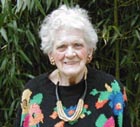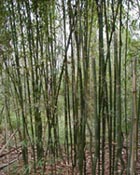| Maryland Newsline |
| Home Page |
Politics
The Newsline video segment on Tufts, from April 6, 2001 (2 min.): Tian Tian and Mei Xiang on the zoo's PandaCams
|
| National Zoo's
Giant Pandas Gobble Up Prince George's Woman's Surplus Bamboo
Capital News Service Sunday, April 8, 2001
WASHINGTON - At age 90, Nancy Poore Tufts has earned two master's
degrees in music, was an organist and church choir director for almost 70
years, drove an ambulance in Washington in the 1940s and was a founder
and longtime director of the Potomac English Hand-bell Ringers group.
But the Fort Washington resident's most famous legacy may be that for
the past 30 years, she has been the main bamboo supplier to the giant
pandas at Washington's National Zoo.
"They come every week at 9 a.m. Monday morning. They used to come at 9
a.m. on Wednesday morning. They've come for 30 years," said Tufts, on
whose 14- acre Potomac River property bamboo grows in abundance.
They stopped coming after the 1999 death of Hsing-Hsing, the last of
first two pandas given to the United States by China in 1972. The zoo's
relationship with Tufts was renewed in December when a new panda pair,
Mei Xiang and Tian Tian, arrived on a 10-year loan from the Chinese
government's panda refuge in Wolong, Sichuan province.
"A [zoo] committee came out this past December and again on January
1st," Tufts said. "They walked all over the place. I said I hope you are
coming to get the bamboo again, because it is taking the place over."
Tufts estimates that bamboo groves cover two acres of her farm, which
has been in her family since 1922 and where she has lived since 1939.
"The bamboo has been growing here since before 1939," Tufts said. "I
wouldn't recommend you plant bamboo...it is so prolific."
Spokesman Mike Morgan said the National Zoo began looking for steady
sources of bamboo in 1972 when it was given the Hsing-Hsing and his mate,
Ling-Ling.
Growing adolescent pandas need to eat huge amounts of bamboo every day--50 to 55 pounds for males and 45 to 50 pounds for females, according
to the National Zoo.
Although many people came forward in 1972, Morgan said the patches
were often too small and also there were occasional disputes between
property owners when a grove straddled a property line.
But Tufts "has a tremendous grove and it solved our bamboo problem,"
Morgan said. He also said the pandas enjoy eating the yellow-groove
variety of bamboo that grows on her property.
"I saw an ad in the old Evening Star saying they needed bamboo
providers. So I knew our bamboo was growing everywhere, it is very hard
to eradicate," she said.
The source of the bamboo was probably none other than Tufts' mother,
an active gardener.
"My mother brought it [the bamboo] from Alabama and South Carolina. My
father was an Army man and we moved around a lot," Tufts said.
But he retired from the Army in 1939, a veteran of the Spanish-American War and World War I, and the family settled on the farm.
Tufts earned master's degrees in music from Syracuse University and in
sacred music from Union Theological Seminary in New York. She was married
in 1941 and, while her husband was overseas in World War II, she worked
as a streetcar operator and an ambulance driver for Casualty Hospital in
Washington.
In 1954, Tufts founded the Potomac English Hand-Bell Ringers group.
Over the next 35 years, she was the director and performed the Christmas
Pageant of Peace at the annual lighting of the National Christmas Tree on
the Ellipse in Washington. She retired from the bell ringers in 1987.
For most of her adult life, Tufts has also served as choir director
and organist at churches in the area, including the last 25 years at
Second Presbyterian Church in Alexandria, Va. She has also written a
number of music books, including "The Art of Hand-Bell Ringing" and "The
Children's Choir."
Now widowed, Tufts never had children, but she hopes that her property
will remain undeveloped and is working with an environmental group to
preserve the land.
In the meantime, she is happy to freely provide bamboo from her
property for the pandas.
"I think this is the least I can do for the National Zoo," she said.
"After all, I'm a citizen; money isn't everything."
Copyright © 2001 University of Maryland College of Journalism.
|


